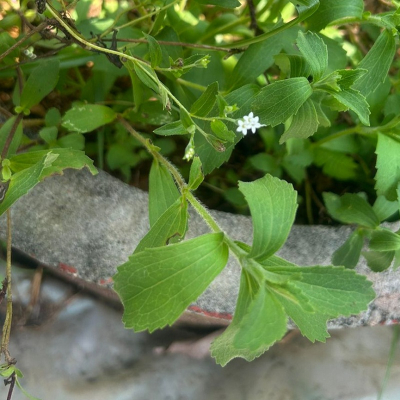Botany: It is an erect perennial herb growing up to 65-75 cm tall with hairy branches and stems.
- Leaves : Serrated above the middle. It has toothed, lance- shaped leaves borne in opposite pairs along the stems
- Flowers : Showy clusters of white flower heads, each head made up of 5 tiny florets. The flowers develop into hard, one seeded fruits (achenes). Flowers are small, white and arranged in an irregular cyme. It is a short day plant with a critical day length of 13 hrs.
Chemical composition- leaf contains stevioside (5-10%), rebaudioside-A (2-4%), rebaudioside –C(1-2%). Glycosides- flavonoid glycosides, Coumarins, cinnamic acids, Phenyl propanoids and essential oils in small quantities.
Uses:
- Antioxidants and catalyst for alcoholic beverages.
- As sweetener, flavour, diabetic diets, colour and odour enhancers, antioxidants and as alcoholic beverage enhancer.
- Medicinally it is used in toothpaste, mouthwashes, skin care, hypertension treatment and capsule additive to improve taste.
Agrotechnology
Climate and soils:
- Grown as a perennial in subtropical and mild temperate regions but must be grown as an annual in mid and high altitudes. This is a short day plant.
- Average maximum and minimum temperatures should not exceed 37 and 10° C respectively during the active crop growth period; the crop thrives well in relative humidity ranging from 65-85%.
- Can be grown well on a wide range of soils. It performs better in well-drained red soil and sandy loam soil. Soil pH should be with in the range of 5.5-7.5. Most of the soils good for vegetables are also suitable for stevia cultivation.
Propagation: Cuttings, seeds
Seed germination is very poor due to infertile seed. Artificial cross pollination is required for setting seeds. A high density of bees is good for high seed production. Excess shade may reduce the rate of flowering. Fertile seeds are dark coloured. Seeds are germinated in green house and transplanting of seedlings done at 45-60 days. Cuttings of new stems and tissue culture are common methods. 15-20 cm long stem cutting having 4-5 nodes root easily.
Manures and fertilizers: 25-30 ton /ha farmyard manure applied at the time of field preparation.
Irrigation: Stevia cannot tolerate drought, therefore frequent irrigation is required, first irrigation is given immediately after transplanting and another after 2-3 days. Subsequent watering is done weekly till onset of monsoon.
Harvesting: The first harvest is taken 75-90 days after transplanting in the month of June-July. Subsequent harvest is taken after 65-75 days of the first harvest in early September at the time of flower bud initiation. In case of late transplanting crop grown for single cut, harvesting is done after 3-4 months of transplanting and continued till flowering begins as the sweetener is maximum in the leaves till the plant flowers. Perennial crop may continue up to four years, once planted in the same field.


